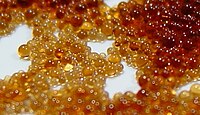
Photo from wikipedia
Over the last two decades, metal–organic frameworks (MOFs) have received great attention and the number of compounds reported is still growing, which is mainly due to their amazing structures and… Click to show full abstract
Over the last two decades, metal–organic frameworks (MOFs) have received great attention and the number of compounds reported is still growing, which is mainly due to their amazing structures and various pore topologies, accessible cages and their potential applications in different fields, such as gas storage, separation, ion-exchange and catalysis. Among these, ion-exchange processes are considered as the post-synthetic parturient technique as it can achieve dominant applications. There are two primary types of ion-exchange processes (anionic and cationic) and each type may use naturally occurring and synthetic materials. The cation-exchange process at the SBUs of MOFs and metal-exchange involving metal nodes in MOFs, have been previously reported. In this study, we attempt to give an overview of all types of ion-exchange processes that occur in the pores and study their applications. We studied the aspects relating to the new MOFs that are driven during their use in ion-exchange: for example, why ion-exchange occurs, a comparison between the MOFs before and after the ion-exchange process and their current applications.
Journal Title: RSC Advances
Year Published: 2017
Link to full text (if available)
Share on Social Media: Sign Up to like & get
recommendations!